
By Kay Smythe
Analysis published Friday detailed a deadly threat lurking in plain sight that could one day silently kill countless humans … and I’ve been screaming about it since I presented on it at university almost a decade ago, so I’m glad to bring you even more information on this impending disaster.
The most dangerous region in the world is surprisingly not run by members of the Democratic party, but is located on the banks of Lake Kivu in the Democratic Republic of Congo (DRC) and Rwanda. Aside from the ongoing humanitarian crises plaguing these nations, Lake Kivu poses one of the most deadly yet silent threats known to mankind: the limnic eruption.
Lake Kivu is not a normal body of water. It is so intensely saturated with dissolved carbon dioxide and methane that it could “explode” at any time. But not how you think, nor how LiveScience described it.
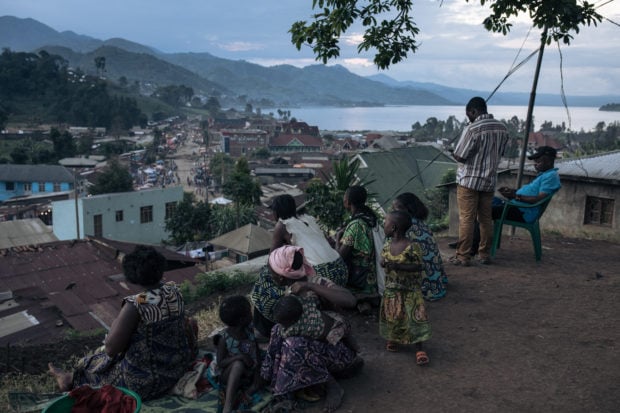
War-displaced women and children sit next to a church where more than 200 families have taken refuge in the center of Minova, South Kivu province, in the East of the Democratic Republic of Congo, on March 10, 2024. In early February, M23 rebels, backed by the Rwandan army, took control of the road linking Goma, capital of North Kivu, to Minova and Bukavu, causing the Congolese army to flee to Minova as well as tens of thousands of civilians. The only remaining access route to Minova is via Lake Kivu. Humanitarian aid for the nearly 300,000 displaced people in Minova is almost inexistent. In Eastern DRC, over 1.5 million people are displaced by the advance of the M23, which took up arms again at the end of 2021. (Photo by ALEXIS HUGUET / AFP) (Photo by ALEXIS HUGUET/AFP via Getty Images)
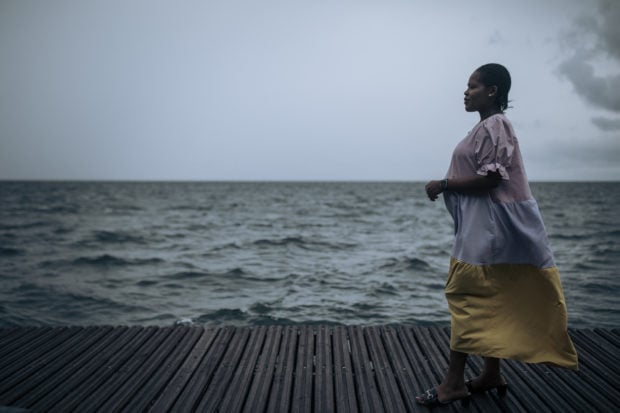
Rachel Sematumba, about to give birth to her first child, poses for a photograph in front of Lake Kivu, which marks the border between the Democratic Republic of Congo and Rwanda, in Goma, eastern DRC, on April 2, 2024. Rachel Sematumba, Congolese, born in Goma in August 1994, describes herself as “a child of war”. “Since my birth at the time of the genocide in Rwanda until now with the M23 (rebel militia), there’s only been war in Goma”, Sematumba said. For 30 years, the Rwandan regime has argued that the presence of Hutu extremists in North Kivu poses a threat that justifies military intervention in DRC, directly or via rebel groups. Rwanda will on April 7, 2024 commemorate the 30th anniversary of the genocide during which Hutu extremists targeting the Tutsi minority slaughtered around 800,000 people in a massacre lasting 100 days. (Photo by ALEXIS HUGUET/AFP via Getty Images)
Imagine this: you wake up on the top bunk of your bed. Things are quiet. Too quiet. You jump down and find your family, animals, neighbors, their bodies strewn throughout your home and the surrounding area. You try to scream but the world is going white. And then you’re dead.
Two major limnic eruptions have occurred in the last 40 years: Lake Nyos and Lake Monoun, both in Cameroon. More than 3,000 cattle and 1,700 to 1,800 people died in the former, while 37 people were killed in the latter. But both of these lakes are tiny in comparison to Kivu. (RELATED: Get Ready For A Category 6 Hurricane, But Not In The Way You Think)
Lake Nyos is 390 acres. Kivu is 667,184 acres.
A man walks past dead cattle after the gas eruption of Lake Nyos, Cameroon, 1986. This seemingly harmless blue freshwater crater lake killed over 1,700 people and all animal life in the surrounding area in one of the strangest natural disasters of all time.#History pic.twitter.com/MQUhsi2eRZ
— Olaudah Equiano® (@RealOlaudah) October 19, 2021
What makes this area even more dangerous is its proximity to Mount Nyiragongo, a fairly active and extremely dangerous stratovolcano. In 1977, Nyiragongo vomited lava through fissures down its flank that traveled at speeds of more than 60 miles per hour, the fastest ever recorded in human history. (RELATED: Scientists Reveal Ancient Cataclysm That Plunged The World Into Darkness 1,500 Years Ago)
And, yes, it is my opinion that a serious eruption, earthquake or even ongoing harmonic tremors from a smaller eruption could be enough to dislodge the gases in Kivu, suffocating the potentially over two million people who live on its shores. But those aren’t the only risks.
“When the lake reaches 100% saturation [in the bottom layer] — and it is currently somewhere over 60% — it will erupt spontaneously,” Hydragas Energy engineer and founder Philip Morkel, who hopes to help extract the gas before this very likely disaster hits, told National Geographic.
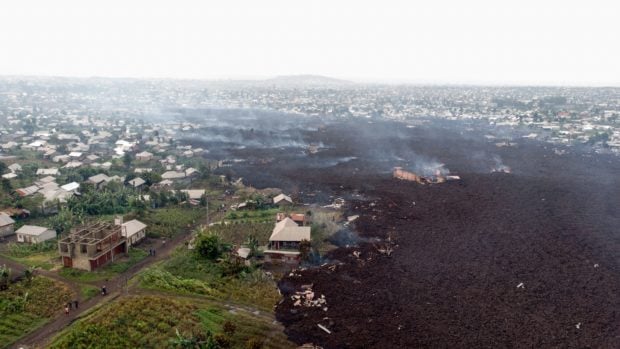
TOPSHOT – This aerial view shows debris engulfing buildings in Bushara village, Nyiragongo area, near Goma, on May 23, 2021, after a volcanic eruption of Mount Nyiragongo, that sent thousands fleeing during the night in eastern Democratic Republic of Congo. A river of boiling lava from the eruption of Mount Nyiragongo has came to a halt outside Goma, sparing the city in the east of the Democratic Republic of Congo, the military governor of the region said on May 23, 2021. Five people were killed in related accidents. (Photo by Justin KATUMWA / AFP) (Photo by JUSTIN KATUMWA/AFP via Getty Images)
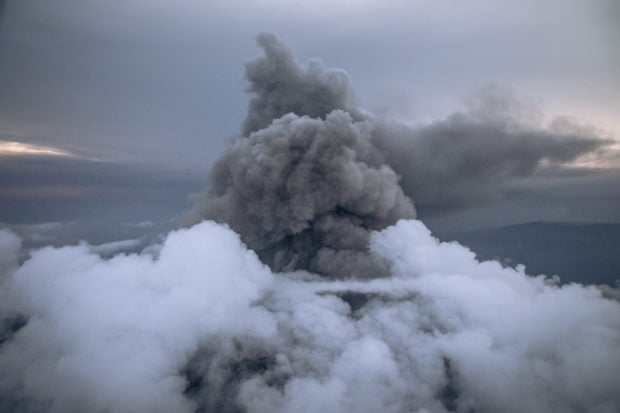
TOPSHOT – This aerial photo taken on May 30, 2021 shows the column of ash expelled from the crater of Nyiragongo volcano, north of Goma, the provincial capital of North Kivu. The Nyiragongo, Africa’s most active volcano, located in the Virunga National Park, erupted on May 22, 2021, killing 32 people and sweeping away the electricity facilities. The possibility of a second eruption in the coming days is not ruled out by scientists on the ground. (Photo by ALEXIS HUGUET / AFP) (Photo by ALEXIS HUGUET/AFP via Getty Images)
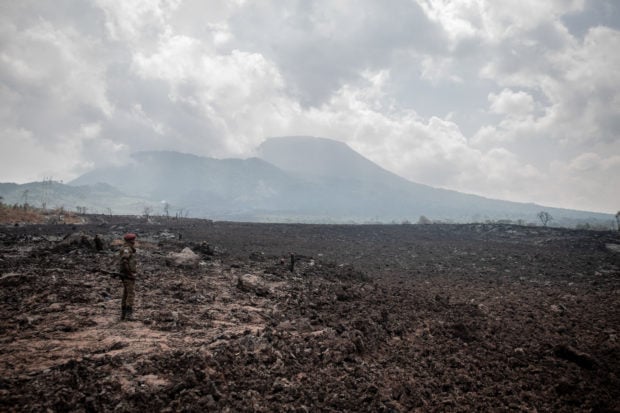
A Republican Guard soldier stands guard over the solidified lava flow during a visit by Democratic Republic of Congo President Felix Tshisekedi to Goma, the provincial capital of North Kivu, on June 14, 2021. – The president visited Goma stricken by the eruption of the Nyiragongo volcano on May 22, 2021 which caused the death of about thirty people and the evacuation of nearly half a million people. (Photo by GUERCHOM NDEBO / AFP) (Photo by GUERCHOM NDEBO/AFP via Getty Images)
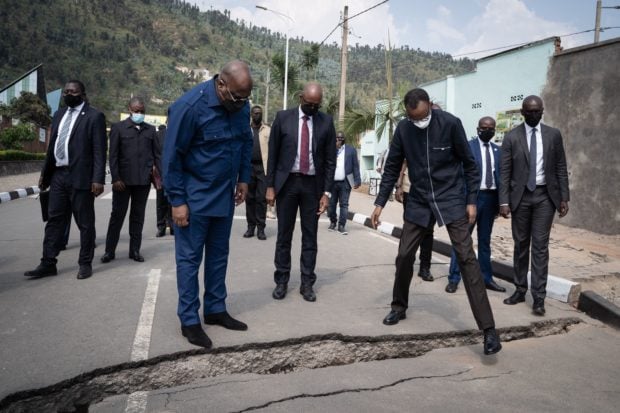
Rwandan President Paul Kagame (C-R) and Democratic Republic of Congo (DRC) President Felix Tshisekedi (C-L) inspects a crack in the road in Rubavu, Rwanda, on June 25, 2021. – Both Presidents visited places in Rubavu that was damaged by the eruption of the Nyiragongo volcano on May 22, 2021 2021. During this eruption many residents of Goma in the DRC fled to Rwanda to find refuge. This meeting in Rubavu will be followed by another visit on May 26, 2021 in Goma, DRC, where Rwandan President Paul Kagame and DR Congo President Felix Tshisekedi will visit places destroyed by the eruption. (Photo by Simon Wohlfahrt / AFP) /
“If anyone were in that cloud, it would take a minute to kill them,” Morkel noted to National Geographic, basically copying what I already told you, but it bears repeating.
Residents of the region already have to contend with mazukus, the Swahili word for “evil wind.” These pockets of gas leach through the ground, “forming invisible and sometimes deadly pools, especially on windless nights,” The Guardian described. Victims often report feeling sick and dizzy, and then tend to collapse and die.
So, while you’re enjoying your weekend watching American politics collapse around you, please remember how lucky you are to live here.


